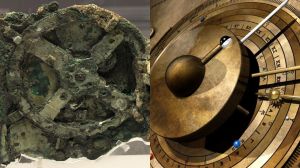The Antikythera Mechanism, an incredible 2,000-year-old artifact that has gained fame as the first known analog computer, has excited the imaginations of the public and experts alike since it was recovered from an ancient Mediterranean shipwreck more than a century ago.
Over the decades, researchers have unraveled the mysteries of this beautiful object, which used a sophisticated system of gears to keep track of cultural events, such as the Olympics, and to predict the motions of celestial bodies along the Saros Cycle, a 18-year period that is punctuated by lunar and solar eclipses.
Videos by VICE
Recent studies have unveiled dazzling digital reconstructions of the mechanism and pinned down its intricate inner workings, even though much of the artifact eroded away or was lost during its long entombment under the sea. Some experts have even speculated that the mechanism was designed or invented by Archimedes, the famed Syracusan polymath who lived in the 3rd century BC.
Now, a team led by Aristeidis Voulgaris, a researcher based at the Thessaloniki Directorate of Culture and Tourism in Greece, has revealed yet another new chapter in the evolving story of this ancient computer. Voulgaris and his colleagues believe they have pinned down the “initial calibration date” of the mechanism—meaning, the point in time that the whole system is referentially built upon—to December 22nd and 23rd, 178 BC, according to a recent study published on the preprint server arXiv.
“The special design, the very large number of parts and the complex construction of the Antikythera Mechanism lead to the conclusion that it was used in order to measure/calculate the time presenting the exported results/calculations via its pointers and scales,” said Voulgaris’ team in the study, which is not yet peer-reviewed. “It is obvious that the manufacturer of the Mechanism designed/constructed his creation and engraved the specific Saros eclipse sequence events, for a specific Epoch/initial date.”
Indeed, the Saros Cycle is explicitly built into the design of the Antikythera Mechanism in the form of a spiral dial that predicts lunar and solar eclipses. Researchers have tried to run the clock back in time before, with one previous study identifying an eclipse noted by the artifact that occurred on May 12, 205 BC.
Voulgaris and his colleagues arrived at a later date for a few reasons, including the positioning of the New Moon phase in the mechanism. They interpret the position of this phase to mean that the Saros Cycle would begin with an annular solar eclipse, a celestial event that occurs when the Moon is at its furthest position from Earth. As a result of this distance, the Moon does not fully block out the Sun’s light, causing an effect known as the “ring of fire.”
To test their assumption, the team reviewed annular solar eclipses that occurred across centuries of ancient Greek history. In particular, they looked for eclipses that coincided with other significant events that might distinguish a date as a compelling yardstick for the mechanism.
Ultimately, the researchers settled on the annular eclipse that graced the skies on December 22nd, 178 BC, because it featured “a rare coincidence of astronomical events,” according to the study. The eclipse happened one day before the Winter Solstice, which was a start date for many calendars at this time, and it also corresponded to the Sun crossing into the zodiac sign of Capricorn.
Voulgaris and his colleagues note that the Winter Solstice is prominently referenced on the mechanism, suggesting it was an important date to the maker, or makers, of the artifact. They also point out that those same winter dates marked “the celebration of the religious festival of Isia started in Egypt and the Hellenistic Greece,” a “unique coincidence” that distinguishes this point in time as “an ideal, functional and representative initial date, in order to calibrate the initial position of the Mechanism’s pointers,” according to the study.
The new study has potentially identified an important reference point for the operation of the Antikythera Mechanism, though it will take more research to corroborate the team’s hypothesis and the many other open questions about this perplexing machine and its creators.





